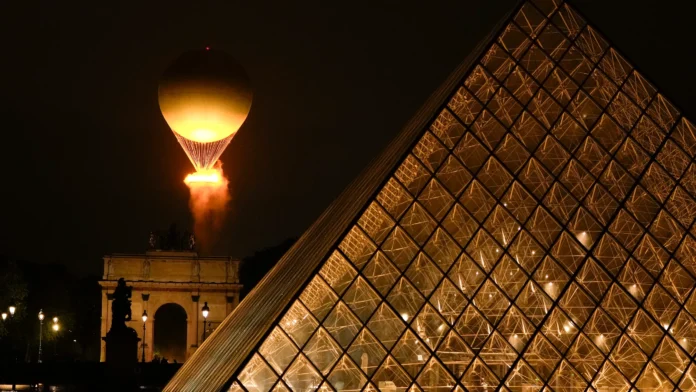For the first time in Olympic history, the cauldron took flight during the Paris Games. The cauldron, a massive 7-meter (23-foot) diameter ring of fire, was supported by a giant air balloon, creating a spectacular sight as it soared through the Parisian sky. The night the Olympic and Paralympic cauldron made its debut flight, designer Mathieu Lehanneur held his breath. With a mix of excitement and anxiety, he hoped nothing would go wrong.
The concept of flying the cauldron was unprecedented. The balloon, lit by the Olympic torch, had never been tested in its entirety before this moment. While individual components, such as the balloon and the flame system, had undergone rigorous testing, the complete setup had only been assembled for the first time during the opening ceremony. This made the cauldron a high-risk venture, akin to an Olympic-sized gamble.
As the golden balloon ascended and illuminated the Paris sky, it became the highlight of Friday’s opening ceremony. Spectators were mesmerized by the sight of the cauldron flying above the city, a dazzling display that added a unique touch to the Games. The flight was a dramatic culmination of Lehanneur’s design efforts and a significant moment for the Olympic festivities.
Lehanneur, who also designed the Olympic Torch, experienced the reveal of the finished cauldron alongside the global audience. The secrecy surrounding the project meant that he, too, saw the complete cauldron in action for the first time during the ceremony. “The most important thing for me is that I discovered the finished cauldron at the same time as everyone else,” Lehanneur said.
The successful flight of the cauldron not only showcased a historic first but also highlighted the innovative spirit behind the Paris Olympics. The event’s opening ceremony left a lasting impression, with the flying cauldron serving as a symbol of both tradition and modernity in the world of sports.
The airborne cauldron brought a sense of wonder and excitement to the Paris Olympics, marking a significant departure from tradition. The concept of a floating cauldron was a bold and imaginative choice, reflecting a desire to innovate and captivate the audience. The technical challenge of combining a giant balloon with a flaming cauldron pushed the boundaries of what had been done before.
As the balloon floated gracefully across the Paris skyline, it represented more than just a visual spectacle. It symbolized the culmination of months of meticulous planning and engineering. The design team had to address numerous logistical challenges to ensure the cauldron’s safe and spectacular flight. The success of the venture underscored the dedication and expertise of everyone involved in bringing this ambitious idea to life.
The reaction from the public was overwhelmingly positive. Viewers around the world were enchanted by the sight of the cauldron suspended in the night sky, its flames flickering against the backdrop of the city lights. The moment captured the imagination of millions, adding a memorable and breathtaking element to the Olympic opening ceremony.
In addition to its visual impact, the flying cauldron also demonstrated the spirit of innovation that characterizes the Paris Games. By embracing new technologies and ideas, the organizers provided a fresh and exciting experience for both participants and spectators. The cauldron’s flight was a testament to the creative thinking and bold experimentation that drive the evolution of the Olympic Games.
The success of the airborne cauldron has set a new benchmark for future Olympic ceremonies. It showed how blending tradition with innovation can create extraordinary moments that enhance the global celebration of sport. As the Paris Olympics continue, the flying cauldron will be remembered as a standout feature, symbolizing the fusion of artistic vision and technical achievement.

